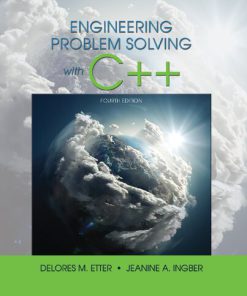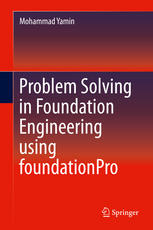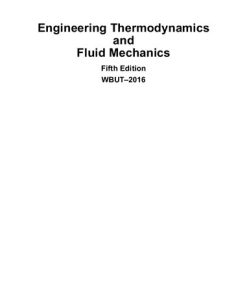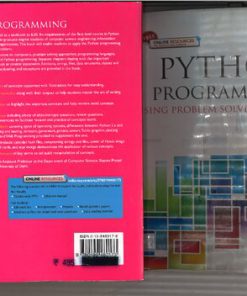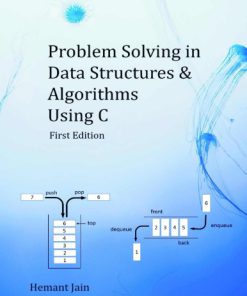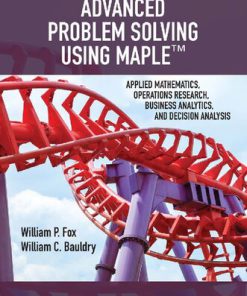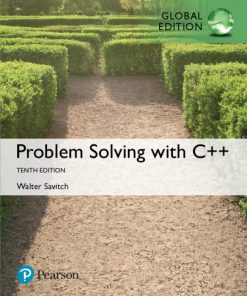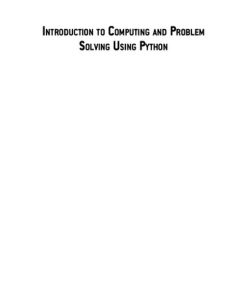Foundations of Fluid Mechanics with Applications Problem Solving Using Mathematica 1st edition by Sergey Kiselev 9783319661490 3319661493
$50.00 Original price was: $50.00.$25.00Current price is: $25.00.
Foundations of Fluid Mechanics with Applications Problem Solving Using Mathematica 1st edition by Sergey Kiselev – Ebook PDF Instant Download/Delivery: 9783319661490, 3319661493
Full download Foundations of Fluid Mechanics with Applications Problem Solving Using Mathematica 1st edition after payment
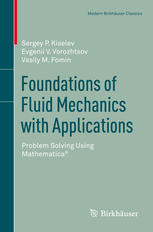
Product details:
• ISBN 10:3319661493
• ISBN 13:9783319661490
• Author:Sergey Kiselev
Foundations of Fluid Mechanics with Applications
Problem Solving Using Mathematica®
This textbook presents the basic concepts and methods of fluid mechanics, including Lagrangian and Eulerian descriptions, tensors of stresses and strains, continuity, momentum, energy, thermodynamics laws, and similarity theory. The models and their solutions are presented within a context of the mechanics of multiphase media. The treatment fully utilizes the computer algebra and software system Mathematica® to both develop concepts and help the reader to master modern methods of solving problems in fluid mechanics. Topics and features: Glossary of over thirty Mathematica® computer programs Extensive, self-contained appendix of Mathematica® functions and their use Chapter coverage of mechanics of multiphase heterogeneous media Detailed coverage of theory of shock waves in gas dynamics Thorough discussion of aerohydrodynamics of ideal and viscous fluidsand gases Complete worked examples with detailed solutions Problem-solving approach Foundations of Fluid Mechanics with Applications is a complete and accessible text or reference for graduates and professionals in mechanics, applied mathematics, physical sciences, materials science, and engineering. It is an essential resource for the study and use of modern solution methods for problems in fluid mechanics and the underlying mathematical models. The present, softcover reprint is designed to make this classic textbook available to a wider audien
Foundations of Fluid Mechanics with Applications Problem Solving Using Mathematica 1st Table of contents:
1 Definitions of Continuum Mechanics
1.1 Vectors and Tensors
1.1.1 Covariant Differentiation
1.1.2 The Levi-Civita Tensor
1.1.3 Differential Operations
1.1.4 Physical Components of Vectors and Tensors
1.1.5 Eigenvalues and Eigenvectors of a Symmetric Tensor
1.1.6 The Ostrogradsky-Gauss Theorem
1.1.7 The Stokes Theorem
1.1.8 The Weyl Formula
1.2 Eulerian and Lagrangian Description of aContinuum: Strain Tensor
1.2.1 Lagrangian and Eulerian Description of a Continuum
1.2.2 Strain Tensor
1.2.3 A Condition for Compatibility of Deformations
1.2.4 Rate-of-Strain Tensor: Cauchy-Helmholtz Theorem
1.3 Stress Tensor
1.3.1 The Cauchy Stress Tensor in the Accompanying Coordinate System
1.3.2 Piola-Kirchhoff Stress Tensors in the Reference Frame and in the Eulerian Coordinates
1.3.3 Principal Values and Invariants of the Stress Tensor
1.3.4 Differentiation of the Stress Tensor with Respectto Time
References
2 Fundamental Principles and Laws of Continuum Mechanics
2.1 Equations of Continuity, Motion, and Energy for a Continuum
2.1.1 Continuity Equation
2.1.2 Equations of Motion and of Momentum Moment
2.1.3 The Energy Conservation Law: The First and Second Laws of Thermodynamics
2.1.4 Equation of State {General Relations)
2.1.5 Equations of an Ideal and Viscous,Heat-Conducting Gas
2.2 The Hamilton-Ostrogradsky’s Variational Principle in Continuum Mechanics
2.2.1 Euler-Lagrange Equations in Lagrangian Coordinates
2.2.2 Hamilton’s Equations in Lagrangian Coordinates
2.2.3 Euler-Lagrange Equations in Eulerian Coordinates and Murnaghan’s Formula
2.3 Conservation Laws for Energy and Momentum in Continuum Mechanics
2.3.1 Conservation Laws in Cartesian Coordinates
2.3.2 Conservation Laws in an Arbitrary Coordinate System
References
3 The Features of the Solutions of Continuum Mechanics Problems
3.1 Similarity and Dimension Theoryin Continuum Mechanics
3.2 The Characteristics of PartialDifferential Equations
3.3 Discontinuity Surfaces mContinuum Mechanics
References
4 Ideal Fluid
4.1 Integrals of Motion Equationsof Ideal Fluid and Gas
4.1.1 Motion Equations in the Gromeka-Lamb Form
4.1.2 The Bernoulli Integral
4.1.3 The Lagrange Integral
4.2 Planar Irrotational Steady Motionsof an Ideal Incompressible Fluid
4.2.1 The Governing Equations of Planar Flows
4.2.2 The Potential Flow past the Cylinder
4.2.3 The Method of Conformal Mappings
4.2.4 The Problem of the Flow around a Slender Profile
4.3 Axisymmetric and Three-Dimensional Potential Ideal Incompressible Fluid Flows
4.3.1 Axially Symmetric Flows
4.3.2 The Method of Sources and Sinks
4.3.3 The Program prog4-5.nb
4.3.4 The Transverse Flow around the Body of Revolution: The Program prog4-6.nb
4.4 Nonstationary Motion of a Solid in the Fluid
4.4.1 Formulation of a Problem on Nonstationary Body Motion in Ideal Fluid
4.4.2 The Hydrodynamic Reactions at the Body Motion
4.4.3 Equations of Solid Motion in a Fluidunder the Action of Given Forces
4.5 Vortical Motions of Ideal Fluid
4.5.1 The Theorems of Thomson, Lagrange, and Helmholtz
4.5.2 Motion Equations in Friedmann’s Form
4.5.3 The Biot-Savart Formulas and the Straight Vortex Filament
References
5 Viscous Fluid
5.1 General Equations of ViscousInconapressible Fluid
5.1.1 The Navier-Stokes Equations
5.1.2 Formulation of Problems for the System of theNavier-Stokes Equations
5.2 Viscous Fluid Flows at SmallReynolds Numbers
5.2.1 Exact Solutions of the System of Equationsfor a Viscous Fluid
5.2.2 Viscous Fluid Motion between TwoRotating Coaxial Cylinders
5.2.3 The Viscous Incompressible Fluid Flow arounda Sphere at Small Reynolds Numbers
5.3 Viscous Fluid Flows at LargeReynolds Numbers
5.3.1 Prandtl’s Theory of Boundary Layers
5.3.2 Boundary Layer of a Flat Plate
5.4 Turbulent Fluid Flows
5.4.1 Basic Properties of Turbulent Flows
5.4.2 Laminar Flow Stability and Transition to Turbulence
5.4.3 Turbulent Fluid Flow
References
6 Gas Dynamics
6.1 One-Dimensional Stationary Gas Flows
6.1.1 Governing Equations for Quasi-One-DimensionalGas Flow
6.1.2 Gas Motion in a Variable Section Duct:Elementary Theory of the Laval Nozzle
6.1.3 Planar Shock Wave in Ideal Gas
6.2 Nonstationary One-Dimensional Flows of Ideal Gas
6.2.1 Planar Isentropic Waves
6.2.2 Gradient Catastrophe and Shock Wave Formation
6.3 Planar Irrotational Ideal Gas Motion(Linear Approximation)
6.3.1 Governing Equations and Their Linearization
6.3.2 The Problem of the Flow around a Slender Profile
6.4 Planar Irrotational StationaryIdeal Gas Flow (General Case)
6.4.1 Characteristics of Stationary IrrotationalFlows of Ideal Gas, Simple Wave:The Prandtl-Meyer Fl
6.4.2 Chaplygin’s Equations and Method
6.4.3 Oblique Shock Waves
6.4.4 Interference of Stationary Shock Waves
6.5 The Fundamentals of the GasdynamicDesign Technology
6.5.1 The Basic Algorithm
6.5.2 The Superposition Procedure
6.5.3 The Complement Procedure
References
7 Multiphase Media
7.1 Mathematical Models of Multiphase Media
7.1.1 General Equations of the Mechanics ofMultiphase Media
7.1.2 Equations of a Two-Phase Medium of the Type ofGas-Solid Particles
7.1.3 Equations of a Bicomponent Mediumof Gas Mixture Type
7.2 Correctness of the Cauchy Problem:Relations at Discontinuities inMultiphase Media
7.2.1 The Characteristics of a System of Equationsfor Gas-Particle Mixtures and Correctnessof the Ca
7.2.2 Jump Relations
7.3 Quasi-One-Dimensional Flows of a Gas-Particle Mixture in Laval Nozzles
7.3.1 The Equations of the Quasi-One-DimensionalFlow of a Gas-Particle Mixture
7.3.2 The Flow of a Gas-Particle Mixture in theLaval Nozzle with Small Velocity andTemperature Lags
7.4 The Continual-Discrete Model and Caustics in the Pseudogas of Particles
7.4.1 The Equations of the Continual-Discrete Modelof a Gas-Particle Mixture at a Small VolumeConcen
7.4.2 Investigation of Caustics in the Pseudogas of Particles
7.5 Nonstationary Processesin Gas-Particle Mixtures
7.5.1 Interaction of a Shock Wave with a Cloud of Particles
7.5.2 Acoustic Approximation in the Problem of Shock Wave Interaction with a Particle’s Cloudat a Sm
7.6 The Flows of Heterogeneous Media without Regard for Inertial Effects
7.6.1 The Brownian Motion of Particles in a Fluid
7.6.2 Fluid Filtration in a Porous Medium
7.7 Wave Processes in Bubbly Liquids
7.7.1 Equations of the Motion of a Bubbly Liquid
7. 7.2 Equations for Weak Nonlinear Disturbancesin Bubbly Liquids
7.7.3 Progressive, Weak Nonlinear Waves in Bubbly Liquids
References
Appendix A: Mathematica Functions
Appendix B: Glossary of Programs
Index
People also search for Foundations of Fluid Mechanics with Applications Problem Solving Using Mathematica 1st:
foundations of fluid mechanics with applications
fluid mechanics fundamentals and applications fourth edition
fluid mechanics fundamentals and applications 4th edition solution manual
fluid mechanics fundamentals and applications 4th edition
fluid mechanics fundamentals and applications
You may also like…
Computers - Programming
Engineering
Problem Solving in Foundation Engineering using foundationPro 1st Edition Mohammad Yamin (Auth.)
Computers - Computer Science
Problem Solving in Data Structures & Algorithms Using C First Edition Jain
Computers - Programming
Computers - Computer Science




